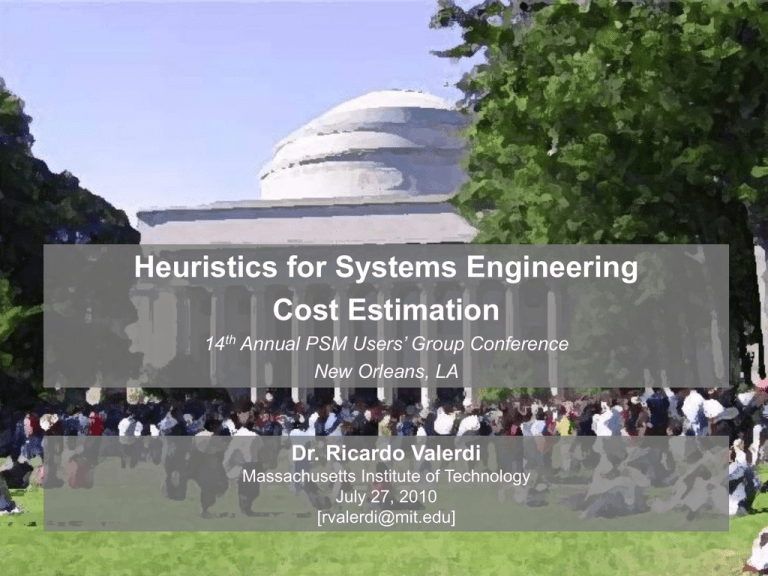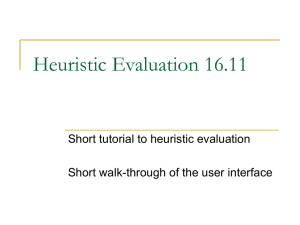Heuristics for Systems Engineering Cost Estimation Dr. Ricardo Valerdi
advertisement

Heuristics for Systems Engineering Cost Estimation 14th Annual PSM Users’ Group Conference New Orleans, LA Dr. Ricardo Valerdi Massachusetts Institute of Technology July 27, 2010 [rvalerdi@mit.edu] Theory is when you know everything, but nothing works. Practice is when everything works, but no one knows why. MIT is where theory and practice come together... Nothing works and no one knows why. - on the door of a laboratory at MIT 2 Outline • • • • Behavioral economics Systems Architecting heuristics by Rechtin Criteria for developing heuristics Four categories of heuristics (Qty. of heuristics) – – – – Development (5) Calibration (6) Usage (16) Estimation (4) • Discussion This presentation is largely based on the paper: Valerdi, R., (in press) Heuristics for Systems Engineering Cost Estimation, IEEE Systems Journal. Acknowledgements For contributing heuristics: Mike Ross, Dan Ligett, Doug Hubbard, Indrajeet Dixit, Marilee Wheaton, Tony Hart, Roger Smith, and Lacey Edwards For inspiration: Barry Boehm, Eberhardt Rechtin For not flunking me in the 6th grade: Ms. Madrazo Bottom Line Up Front 1. Heuristics are effective tools for making decisions when little information is available 2. Heuristics are good ways to capture knowledge and teach 3. Longevity does not translate into quality Definitions • Heuristic – Rule of thumb, educated guess, simplification, intuitive judgment or common sense – strategy using readily accessible though loosely applicable information to control problem-solving in human beings – Example: Work expands so as to fill the time available for its completion* • Bias – an unfair preference for or dislike of something – arises from various life, loyalty and local risk and attention concerns that are difficult to separate or codify – Example: optimism *Parkinson‟s Principle Rational Choice Theory (homo economicus) • Modeling of social & economic behavior • Microeconomic paradigm • Models of rational choice assume individuals choose the best action according to stable preference functions and constraints facing them Prospect Theory • Describes decisions between alternatives that involve risk, i.e. alternatives with uncertain outcomes, where the probabilities are known • The model is descriptive – attempt to model real-life choices rather than optimal decisions Kahneman, Daniel, and Amos Tversky (1979) "Prospect Theory: An Analysis of Decision under Risk", Econometrica, XLVII (1979), 263-291. Tversky & Kahneman Heuristics 2002 Nobel Prize in Economics • Representativeness the degree to which A is representative of B A = completed project B = project being estimated • Anchoring – the ability for people to make an estimate by starting from an initial value that is adjusted to yield the final answer – initial value = a client‟s desired project schedule Kahneman, D., Slovic, P. & Tversky, A. (Eds.). (1982). Judgment under Uncertainty: Heuristics and Biases. Cambridge, UK: Cambridge University Press. Experiential Closed Loop Model Development Heuristics experience lead to Rechtin’s inspired COSYSMO Systems Architecting Model Heuristics Model Calibration Heuristics implemented in COSYSMO Tool Model Usage Heuristics Cost Estimation Heuristics confirmed Elements of Successful Systems Architects 1. Know the engineering fundamentals on which each architecture is based • Common sense, derived from specific engineering fundamentals and the experience of other architects, is needed to reduce the search to practical dimensions 2. Experience and judgment are necessary • Hands-on system problem solving is mandatory 3. Acquire the insights gained from experience in the design laboratories on the job Rechtin, E. 1991. Systems Architecting: Creating & Building Complex Systems, Upper Saddle River: Prentice Hall. Systems Architecting Heuristic (Rechtin 1991) COSYSMO Cost Driver Success is defined by the beholder (understand Number of System his or her requirements) not by the architect Requirements The greatest leverage in systems architecting is Number of Major Interfaces at the interfaces One person‟s architecture is another person‟s system is another person‟s component Architecture Understanding There will always be friction on the “illity” boundary Level of Service Requirements If you don‟t understand the existing system you Migration complexity can‟t be sure you are re-architecting a better one “Proven” and “State of the Art” are mutually exclusive qualities Technology Maturity Amid a wash of paper, a small number of documents become critical pivots around which every project manager revolves Documentation to Match Life Cycle Needs Organize personnel tasks to minimize the time individuals spend interfacing # and Diversity of Installations & Platforms A strong coherent constituency is essential Stakeholder Team Cohesion Criteria for Developing Heuristics 1. Agreement among experts that the heuristic is useful and correct 2. Heuristic must stand the test of time 3. Heuristic must be resilient across different scenarios 4. Heuristic must demonstrate value by – reoccurring more than once – Not be considered obvious by everybody, particularly people who are new to the field Model Development Heuristics • • • • Heuristic #1: More parameters increase the explanatory power of the model, but too many parameters make the model too complex to use and difficult to calibrate. Heuristic #2: Break the problem and analysis into life cycle phases; the right amount of granularity is important. Heuristic #3: Let available data drive the application boundaries of the model. Heuristic #4: Design the rating scale according to the phenomenon being modeled. Development-related Heuristic Heuristic #5: Some system characteristics are more likely to be cost penalties than cost savings. Migration Complexity cost driver in COSYSMO Nominal High Very High Extra High Legacy contractor Self; legacy system is well documented. Original team largely available Self; original development team not available; most documentation available Different contractor; limited documentation Original contractor out of business; no documentation available Effect of legacy system on new system Everything is new; legacy system is completely replaced or nonexistent Migration is restricted to integration only Migration is related to integration and development Migration is related to integration, development, architecture and design Calibration-related Heuristic Heuristic #6: All calibrations are local. Before local calibration After local calibration Wang, G., Valerdi, R. and Fortune, J., (in press) Reuse in Systems Engineering, IEEE Systems Journal. Model Calibration Heuristics • • • • • Heuristic #7: Calibrations fix chronic errors in over- or underestimation. Heuristic #8: Be skeptical of data that you did not collect. Heuristic #9: For every parameter in the model, 5 data points are required for the calibration. Heuristic #10: Don’t do more analysis than the data are worth. Heuristic #11: You need less data than you think, you have more data than you think. Usage Heuristics • • • • • Heuristic #12: A model is not reality. Heuristic #13: All models are wrong, but some of them are useful. Heuristic #14: Begin with the end in mind. Heuristic #15: Requirements are king. Heuristic #16: Not all requirements are created equal. Usage-related Heuristic Heuristic #17: Reuse is not free. Example: System requirements New 1.0 Modified vs. New Threshold 0.65 Deleted Adopted Managed 0.51 0.43 0.15 0 Reuse weight Modified Usage Heuristics II • • • • • • Heuristic #18: Operational Scenarios may come first, but requirements will ultimately describe the system. Heuristic #19: Don't double dip. Heuristic #20: Find your sea level. Heuristic #21: Nominal is the norm. Heuristic #22: If you're estimating a large project, personnel capability is Nominal. Heuristic #23: Most of your off-Nominal cost drivers should match your last project. Usage Heuristics III • • • • Heuristic #24: If you're going to sin, sin consistently. Heuristic #25: Use a combination of models to estimate total system cost. Heuristic #26: Avoid overlap between models. Heuristic #27: Estimate using multiple methods (analogy, parametric, etc.) Estimation Heuristics • • Heuristic #28: Estimate early and often. Heuristic #29: Experts all disagree forever. Bound the options they are given to evaluate. Estimating-related Heuristic Heuristic #30: Models are optimistic. Heuristic #31: People are generally optimistic. 120 99 100 80 60 40 20 11 17 6 14 10 2 0 2 H-VH VH 0 VL VL-L L L-N N N-H H SCED on COCOMO II Database Koehler, D. J., Harvey, N. (1997). Confidence judgments by actors and observers. Journal of Behavioral Decision Making. 10, 221-242. Longevity Bias 1. Lure of tradition proves persistent – If something has been around longer, it must be better (wrong!) 2. We hold onto „longevity‟ even in instances where quality has nothing to do with longevity 3. Unfortunately, it may confer legitimacy on otherwise undesirable practices Eidelman, S., Pattershall, J., & Crandall, C.S. (in press). Longer is better. Journal of Experimental Social Psychology. …Bottom Line (Again) 1. Heuristics are effective tools for making decisions when little information is available 2. Heuristics are good ways to capture knowledge and teach 3. Longevity does not translate into quality








